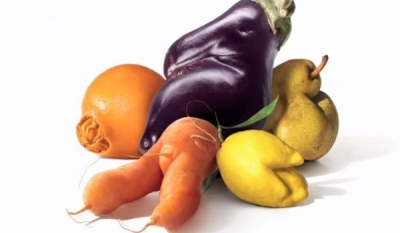New research from Mintel finds as many as half (48%) of UK fruit and vegetable buyers agree that they would buy oddly shaped fruit or vegetables if they were of good quality.
The same research finds a lower price would make these products even more attractive, as some 42% of fruit and vegetable buyers say they would buy oddly shaped fruit and vegetables if they were cheaper.
Meanwhile, over half (56%) of UK adults say they feel that food retailers should do more to reduce the amount of food they throw away, while 28% of consumers are concerned about the amount of fruit or vegetables they waste.
Kiti Soininen, Head of UK Food, Drink & Foodservice Research at Mintel said:
“It is clear that consumers are open to ‘ugly’ produce, but where oddly shaped fruit and veg sits with mainstream offerings, it is at risk of going unchosen, even if subconsciously.
The fact that half of consumers would buy good quality oddly shaped fruit and veg and the recent focus on food waste and the grocers’ role in curbing it shows there is scope to actively use the non-standard quality of produce as a selling point.
In addition, prices come across as a real consideration for many and by positioning ‘ugly’ fruit and vegetables as a tasty, low-cost option should help the grocers to reach this group.”
Today, as many as 93% of all Brits buy fresh fruits weekly, while 90% buy fresh vegetables.
And it seems Britain’s love of fruit and vegetables continues to grow, as 25% of fruit and vegetable shoppers say that compared to a year ago they are cooking at home using fruit and vegetables more often; while one in ten (10%) say they can afford to buy more fresh fruit and vegetables compared to a year ago.
Furthermore, whilst there have been questions over the high sugar content in fruit, less than one in 10 (8%) say they have cut back on buying some fruits because of the sugar content.
Indeed, fruit and vegetables remain a major part of the British diet and thanks to a 16% growth between 2009 and 2014 the combined fruit and vegetable market in the UK, including potatoes, stands at an an estimated £16 billion, up from just under £14 billion in 2009. Looking forward, whilst sales of fruit and vegetables are forecast to rise to just under £19 billion by 2019, it is inflation which is expected to drive this growth.
Moreover, for UK consumers, good value is vital when it comes to stocking the fridge. Over three in five (62%) Brits who buy fresh fruit and vegetables say that low price is important, followed by the best before date (41%) and whether it is on promotion (38%).
Some 35% of Brits would like to see a greater variety of fruit or vegetables available in ready-to-eat snack formats, for example washed, peeled or chopped.
“Rising prices are expected to remain the main driver of value growth, though the impact of weather on crops continues to create an added element of uncertainty.
Until the income squeeze eases significantly, spending on fruit and vegetables as a day-to-day grocery item will remain under scrutiny.
However, certain added-value areas hold potential, such as ready-to-eat snack formats and initiatives that helps to extend shelf life,” Kiti continues.
Mintel’s research also found that overall in the UK, almost half (46%) of fruit and veg buyers say they are trying to eat the recommended five portions of fruit or vegetables per day.
But despite this, half of Brits (50%) agree that it is difficult to eat as many as five portions a day, a figure which rises to 57% of 25-34 year olds. By contrast, taking on board the recommended five a day seems less of a task for the nation’s older generation as just 40% of those aged 65 and over say it is difficult to reach five a day.
Finally, more than two thirds (67%) of Brits think that the health benefits of fruit and vegetables should be stated on packaging, for example the fact that beetroot is high in potassium and magnesium.
“It is now common across much of packaged fruit and vegetables to highlight the product’s nutrient content on-pack, such as the folate and Vitamin A in a bag of salad.
Expanding beyond this to communicate relevant health benefits, something not commonly done in this market, should offer products standout given that most people would like to see the health benefits of fruit and vegetables stated on-pack,” concludes Kiti.























